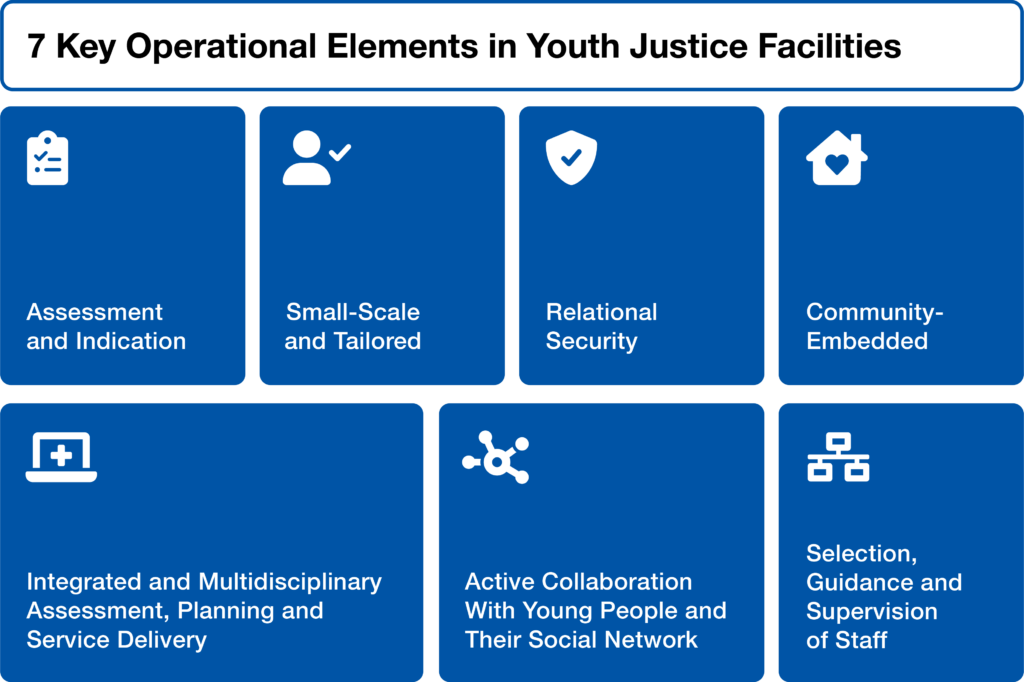
Background
The development and evaluation of a small-scale, community-embedded youth justice remand facility in the Netherlands have yielded transformative lessons. This approach, designed for a diverse youth population, aligns with a graduated justice system, balancing developmental needs with security. Over three years of action research, key insights emerged, reshaping traditional notions of juvenile justice. The article also underscores the imperative for youth justice settings to shift towards safe and therapeutic environments that cater to the specific needs of young individuals. The prevalent existing models are criticized for prioritizing security at the expense of care, ultimately impeding positive development. The three-year evaluation in the Netherlands focuses on small-scale, community-embedded facilities with an emphasis on relational security. The objective is to provide guidance for professionals and policymakers interested in effective youth justice strategies.
Shift in Placement Criteria
Initially, professionals favored placing first or second-time offenders in the facility. However, a pivotal shift occurred during the pilot, emphasizing that offense history alone does not gauge a young person's current motivation for positive change. The focus shifted from rigid criteria to a nuanced understanding of individual circumstances.
Trial and Error Learning
A critical realization was the importance of allowing young people to learn through trial and error. Each placement was treated as a unique situation, emphasizing the dynamic nature of a young person's journey toward rehabilitation. This adaptive approach recognized the evolving needs and motivations of the youth. As the pilot progressed, professionals also de-emphasized the severity of alleged offenses. They contended that offense circumstances, such as motive and provocations, were more indicative of a young person's suitability for placement than a rigid severity scale. This shift highlighted the need for a holistic evaluation.
Reevaluation of Substance Abuse and IQ Criteria
Initially considered strict contraindications, substance abuse and low IQ were later weighed against other criteria. The emerging approach emphasized the importance of balancing these factors with a comprehensive understanding of the individual, challenging preconceived notions of exclusionary criteria.
Active Involvement of Young People and Their Network
Recognizing the limitations of assessing a young person solely based on a case file, active involvement of the youth and their network became imperative. This approach ensured a more comprehensive understanding of a young person's current volitional state, attitudes, and feelings, fostering a more holistic rehabilitation process.
Small-Scale and Tailored Approach
The facility's design, featuring a small scale with eight beds, allowed for a personalized approach. Staff could identify and understand each young person's unique risks, needs, skills, and strengths, tailoring trajectories accordingly. This emphasis on customization underscored the importance of individualized care in juvenile rehabilitation.
Relational Security
At the heart of the security framework was relational security, emphasizing relationships between staff and young people. A basic attitude of connection and attunement, constructive collaboration, and physical presence of professionals were identified as key components. This relational approach aimed to create a safe and therapeutic environment. The facility's integration into the community also proved crucial. Its location near each young person's home environment and collaboration with local resources maintained connections to school, work, and other community activities during confinement. This community-embedded approach aimed to bridge the gap between incarceration and societal reintegration.
Integrated and Multidisciplinary Approach
Adopting an integrated, multidisciplinary approach to assessment, treatment planning, and service delivery, the facility ensured continuity beyond the period of incarceration. Collaboration with external professional stakeholders post-release became integral, recognizing the importance of a seamless transition back into society.
Active Collaboration with Young People and Their Support Network
The principle of active collaboration involved young people and their support networks in intervention planning and service delivery. This tailored approach considered the perspectives of young people and their caregivers, emphasizing the need for their input throughout the confinement period. The collaboration aimed to reduce risks and strengthen protective factors.
Selection, Guidance, and Supervision of Staff
Staff selection prioritized skills over professional qualifications, particularly the ability to genuinely connect with young people. Continuous reflection and weekly supervision sessions, combined with transformational leadership, contributed to a positive work climate and high job satisfaction. This emphasis on staff support recognized the pivotal role they play in creating a safe and therapeutic environment.
Conclusion
The article concludes by highlighting the positive outcomes and wide support for the Amsterdam facility in the Netherlands, emphasizing reduced recidivism and promoting positive youth development. The authors aim to contribute to the knowledge about implementing viable custodial alternatives for young people and provide lessons learned for replication in different contexts. By challenging traditional paradigms, this article argues that considering different models offers valuable insights for policymakers, practitioners, and stakeholders involved in shaping the future of youth justice systems worldwide. It emphasizes that fostering a safe, supportive environment, grounded in relationships, can be pivotal in guiding young individuals towards positive, lasting change.

